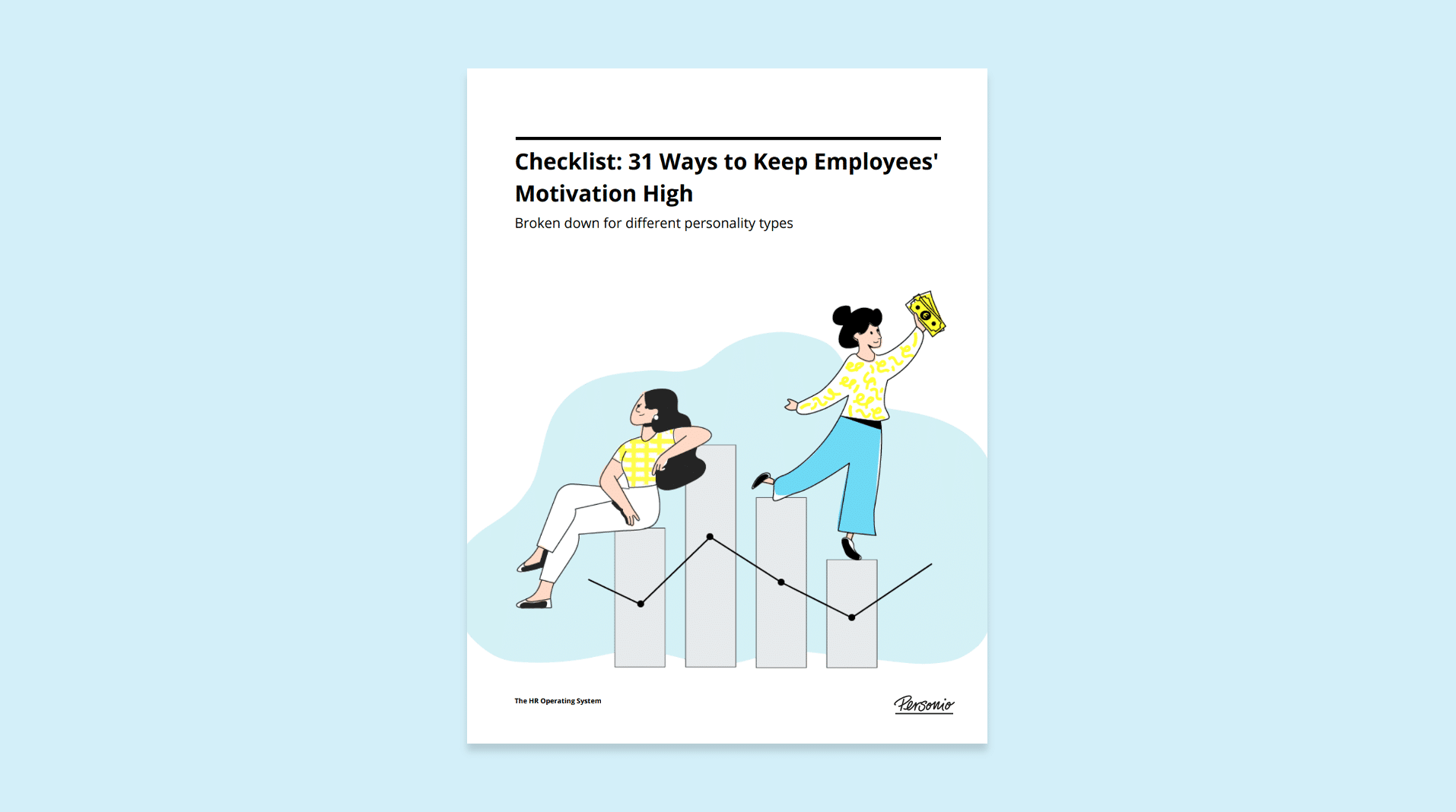Retention Bonus: Factors & Checklist for Success

A retention bonus may be a silver bullet to holding onto your team’s top performers. Rather, they are one tool that can help keep employee satisfaction high (and away from competitors). In this article, we offer an overview of what they are and how to introduce these kinds of bonuses.
Key Facts
Retention bonuses are a lump sum added to an employee’s base pay as an incentive to remain with your company.
Employee retention bonuses demonstrate how much you value top performers.
You can also offer a range of alternatives that have the same impact as a retention bonus.
Contents
- 1What Is a Retention Bonus?
- 2When Should You Consider a Retention Bonus?
- 3Why Might You Consider Offering a Retention Bonus?
- 4Benefits of Offering Retention Bonuses
- 5Drawbacks of Retention Bonuses
- 6Checklist: What To Consider When Offering Retention Bonuses
- 7Are Retention Bonuses Taxable Income?
- 8What Are the Alternatives for a Retention Bonus?
- 9Use Retention Bonuses To Build a Motivated Workforce
- 10Frequently Asked Questions About Retention Bonuses
What Is a Retention Bonus?
An employee retention bonus (ERB) is a lump sum payment on top of an employee’s standard wage offered as a ‘thanks’ for remaining with a company. A retention bonus often equals 10% to 25% of an employee’s base salary.
When Should You Consider a Retention Bonus?
A retention bonus is designed to mitigate disruptions in your workforce, so you’ll often see them distributed during transitional periods, such as a merger or acquisition. It’s also a good idea to consider if staff longevity is a priority for your company, as the financial incentive may sway someone to stay.
Why Might You Consider Offering a Retention Bonus?
There are several reasons why you might consider implementing retention bonuses for your workforce.
Keep Critical Employees in Your Organisation
Some roles require hard-to-find skills, making the employee in that role challenging to replace if they leave. Companies will often offer extra incentives to keep those types of employees in the long term and to help keep them from bringing that valuable set of skills to a competitor. More than that, offering ERBs can help retain staff to see through large projects, ensuring continuity and a more reliable standard of work.
Build Institutional Knowledge
A higher employee retention rate fosters a comprehensive store of company knowledge due to the ongoing presence of senior staff members. This institutional knowledge becomes quite handy to the company, providing insight into effective processes and a deep understanding of how inter-office relationships play out.
Showing Appreciation
ERBs are also a meaningful reward for your top performers. While there are several ways to demonstrate your company’s appreciation for an employee’s contributions to the company, extra money is one of the most effective. Used for this purpose, it’s appropriate to offer retainment bonuses in contexts beyond transition periods. For example, your company can provide one for top employees after a performance review.
Benefits of Offering Retention Bonuses
Retention bonuses can positively affect your company’s success by providing external motivation for high-performance employees to remain with the company.
Benefits for Employees
Stronger negotiating power. A robust retention strategy allows employees to negotiate bonuses and other benefits if they’re thinking about leaving. This measure provides a stopgap to prevent valuable employees from transitioning out without first arguing their case for higher pay.
Improved workforce morale. Retention bonuses are designed to show your best workers that they’re an asset to the company and help maintain strong employee relations. As a result, a more robust connection builds between employees and your organisation, motivating them to work more thoughtfully for better task results.
Sign of appreciation. ERBs are a way to show an employee how valuable they are to their team and the company as a whole.
Benefits for Organisations
Increased employee engagement. Retention bonuses help provide stability during stable times and periods of significant internal shifts like mergers. The added encouragement to remain in key positions bolsters productivity and stability company-wide.
Better company resilience. Providing retention bonuses over time makes it more likely that your employees stay with the company. A loyal workforce is a stalwart of stability that’s essential for smooth operations.
Measure Performance Objectively & Transparently

Keep an eye on employee development with definable and trackable goals. Goals can also become linked to bonus payouts to help boost retention.
Performance With Personio
Drawbacks of Retention Bonuses
Despite the numerous benefits of retention bonuses, there are drawbacks to consider before implementing them into your organisational strategy.
Drawbacks for Employees
Doesn’t contribute to job satisfaction. While extra money is a fairly reliable motivator, it will only work to a point. If an employee’s job satisfaction is particularly low, a bonus won’t do much to increase it.
May raise workplace tension. Retention bonuses are not always equally distributed or offered to all employees at every level in the company. This may create resentment among some workers who may find this unfair.
Does not address underlying problems. Using ERBs to mitigate employee turnover isn’t a permanent solution. Treating it like one could mean letting a deeper problem fester and cause more damage to your organisation’s workforce.
Drawbacks for Organisations
May be interpreted negatively. A retention bonus can be seen as an attempt for your company to buy loyalty, depending on the contexts it’s offered in.
It avoids delving into larger issues. ERBs can help mitigate the effects of high turnover, but only for so long. If you’re not asking why employees are leaving or want to leave, you avoid getting to the heart of the matter.
Checklist: What To Consider When Offering Retention Bonuses
Even after deciding to implement ERBs as part of your HR retention strategy, there are still factors to note before launching the programme. These factors include:
The health of the job market. Are companies in your field hiring right now? A lean or fluctuating job market can make finding employees for more complex roles challenging. If you have workers in roles you believe would be hard to replace, offering a retention bonus can help keep your best people.
Employee seniority. How long has the employee worked for you? Long-term employees are often a wealth of knowledge on company procedures. Keeping them on for as long as possible tends to be a net gain.
Company finances. Does your company have the resources to offer – and follow through on – substantial retention bonuses? ERBs are often cost-effective compared to finding and training new employees. Although, they can be an untenable expense if your company didn’t budget for these costs.
The cost of losing an employee. How much would it cost to replace a departing employee? The general rule of thumb is that replacing an employee costs around three to four times their annual salary, typically making ERBs the less expensive option. If a departing worker was paid £60,000, finding and training a new employee would cost around £180,000 to £240,000. In comparison, retention bonuses usually come to around 15% of an employee’s salary, equalling only an extra £9,000 on top of a £60,000 wage.
Salary comparison. How much does the employee make compared to the average industry wage? If they’re below the typical market value for people in their position, a retention bonus can help make up the difference.
Overall performance. How well have they performed within their positions? If they’ve done exemplary work, a promotion and a rise might show them that their contributions are appreciated better than a lump sum added to their wage.
Are Retention Bonuses Taxable Income?
Retention bonuses are considered taxable income according to UK tax laws. As the employer, you must include the bonus amount in the employee’s other earnings and report the total to the HMRC. You’ll also need to deduct income tax and the National Insurance contributions (NICs) from the employee’s regular pay and retention bonus.
What Are the Alternatives for a Retention Bonus?
The purpose of a retention bonus is to incentivise key employees to remain with your company by showing them their value through monetary rewards. But there are other types of incentives that work in different contexts but can produce the same results. Some of those alternative bonuses are:
Spot bonuses. These are small rewards given to employees for completing a specific task. It helps incentivise continued performance while being a more cost-effective option.
Task bonuses. Also called milestone bonuses, companies offer these monetary rewards when a team or singular employee reaches a project goal. Task bonuses can keep team members energised throughout the rest of the project.
Profit-sharing. A percentage of the profit the company made over a certain period is paid to employees. The higher the profit, the higher the bonus, so a company workforce is motivated to deliver high-quality results.
Sign-on bonuses. A lump sum monetary incentive added to a new hire’s first wage. The amount is disclosed during the onboarding process and helps create a positive connection between them and the company.
Use Retention Bonuses To Build a Motivated Workforce
The job market is in near-constant flux, and there’s serious competition for high-quality talent. But looking for those model candidates isn’t as important as keeping your high-potential employees. Losing even one of them can negatively affect your company’s success, and they’re often hard to replace.
Offering bonuses as a part of your business’s retention strategy helps build a positive work environment that mitigates employee turnover and keeps your workforce strong.
Checklist: Employee Engagement & Motivation

Every employee is unique, and what motivates them is no different. Download our checklist for a range of ideas and strategies to keep employee motivation and engagement high.
Download NowFrequently Asked Questions About Retention Bonuses
What Is a Typical Retention Bonus?
Generally, a retention bonus equals 10% to 25% of an employee’s base salary.
Who Can Get a Retention Bonus?
Anyone can receive a retention bonus, but they’re typically reserved for employees with complex or demanding roles for whom it would be difficult to find a replacement. They’re also often used to retain long-term employees with deep institutional knowledge.
Are Retention Bonuses Negotiable?
Yes. Strong retention strategies implement an official negotiation process that allows valuable employees to argue for a higher bonus or other benefits.
How Can You Earn a Retention Bonus?
Employees earn retention bonuses by making themselves invaluable to the company’s continued success through quality work or uncommon skills.
Disclaimer
We would like to inform you that the contents of our website (including any legal contributions) are for non-binding informational purposes only and does not in any way constitute legal advice. The content of this information cannot and is not intended to replace individual and binding legal advice from e.g. a lawyer that addresses your specific situation. In this respect, all information provided is without guarantee of correctness, completeness and up-to-dateness.
